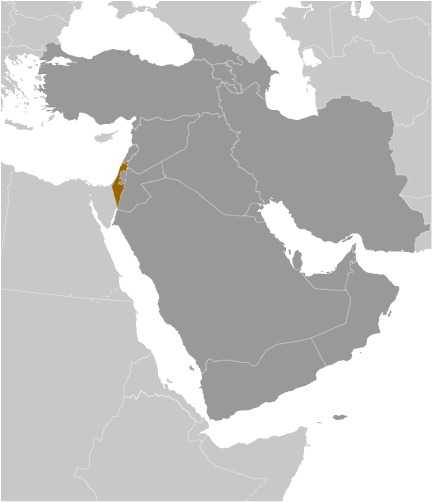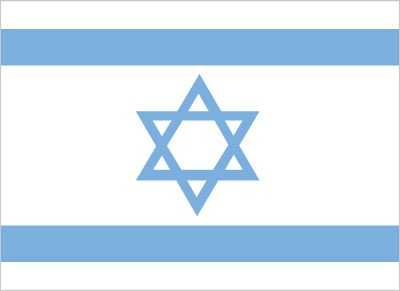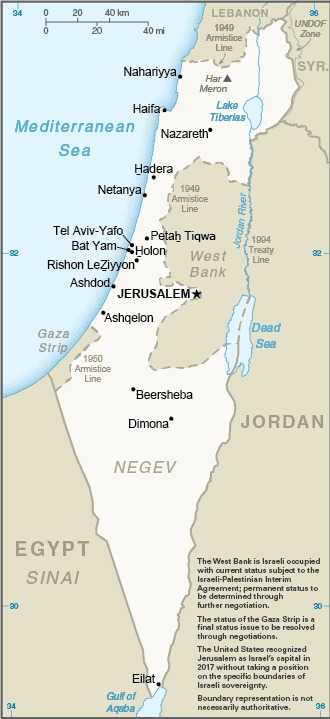Introduction
Background
The State of Israel was declared in 1948, after Britain withdrew from its mandate of Palestine. Israel joined the UN in 1949 and saw rapid population growth, primarily due to migration from Europe and the Middle East. The Israeli economy has undergone a dramatic transformation in the last 25 years, led by cutting-edge high-tech sectors.
Geography
Area
total : 21,937 sq km
land: 21,497 sq km
water: 440 sq km
Climate
temperate; hot and dry in southern and eastern desert areas
Natural resources
timber, potash, copper ore, natural gas, phosphate rock, magnesium bromide, clays, sand
People and Society
Population
total: 9,402,617
Ethnic groups
Jewish 73.5% (of which Israel-born 79.7%, Europe/America/Oceania-born 14.3%, Africa-born 3.9%, Asia-born 2.1%), Arab 21.1%, other 5.4% (2022 est.)
Languages
Hebrew (official), Arabic (special status under Israeli law), English (most commonly used foreign language)
Religions
Jewish 73.5%, Muslim 18.1%, Christian 1.9%, Druze 1.6%, other 4.9% (2022 est.)
Population growth rate
1.58% (2024 est.)
Government
Government type
parliamentary democracy
Capital
name: Jerusalem; note - the US recognized Jerusalem as Israel’s capital in December 2017 without taking a position on the specific boundaries of Israeli sovereignty
Executive branch
chief of state: President Isaac HERZOG (since 7 July 2021)
head of government: Prime Minister Benyamin NETANYAHU (since 29 December 2022)
Legislative branch
description: unicameral Knesset (120 seats; members directly elected in a single nationwide constituency by closed party-list proportional representation vote, with a 3.25% vote threshold to gain representation; members serve 4-year terms)
Economy
Economic overview
high-income, technology- and industrial-based economy; economic contraction and fiscal deficits resulting from war in Gaza; labor force stabilizing following military reservist mobilization; high-tech industry remains resilient while construction and tourism among hardest-hit sectors
Real GDP (purchasing power parity)
$471.03 billion (2023 est.)
$461.808 billion (2022 est.)
$432.271 billion (2021 est.)
Real GDP per capita
$48,300 (2023 est.)
$48,300 (2022 est.)
$46,100 (2021 est.)
Agricultural products
milk, chicken, potatoes, tomatoes, avocados, bananas, grapefruits, eggs, tangerines/mandarins, carrots/turnips (2022)
Industries
high-technology products (including aviation, communications, computer-aided design and manufactures, medical electronics, fiber optics), wood and paper products, potash and phosphates, food, beverages, and tobacco, caustic soda, cement, pharmaceuticals, construction, metal products, chemical products, plastics, cut diamonds, textiles, footwear
Exports
$156.165 billion (2023 est.)
$166.227 billion (2022 est.)
$143.505 billion (2021 est.)
Exports - partners
US 25%, China 7%, West Bank/Gaza Strip 6%, Ireland 5%, UK 4% (2022)
Exports - commodities
diamonds, integrated circuits, refined petroleum, fertilizers, medical instruments (2022)
Imports
$137.567 billion (2023 est.)
$150.804 billion (2022 est.)
$125.948 billion (2021 est.)
Imports - partners
China 14%, US 11%, Turkey 7%, Germany 6%, India 5% (2022)
Imports - commodities
diamonds, cars, crude petroleum, refined petroleum, garments (2022)
Exchange rates
new Israeli shekels (ILS) per US dollar -
Page last updated: Wednesday, July 24, 2024




